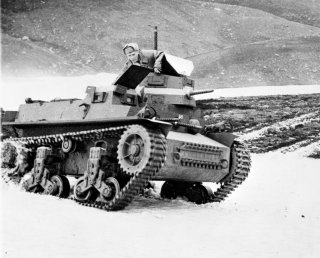This Is Strange Looking: How An American 'Tankette' Fought the Japanese in Alaska
The War Department issued the CTLS U.S. Army tankers as an emergency measure.
Light tanks are usually considered relics of the past. Take Nazi Germany’s Sonderkraftfahrzeug, which used one variant to destroy enemy bunkers via remote control. Or the present-day Bundeswehr’s Weisel reconnaissance tankette that is still in service despite its small size and limited firepower. We won’t see any American tankettes rolling off assembly lines anytime soon, but this lesser-known American tankette did a brief stint in Alaska during World War II.
Marmon-Herrington CTLS
In an effort to find an amphibious light tank, the United States Marine Corps turned to the truck and tractor manufacturer Marmon-Herrington and solicited a light tank design. In compliance with the Marine Corps’ design specifications, the Marmon-Herrington CTLS was quite small and had room for just two—a gunner and a driver.
The tiny tank was lightly armed as well. Though production model’s armament varied somewhat, the Marmon-Herrington CTLS in American service were generally armed with either a turret-mounted .50 caliber machine gun or a .30 caliber machine gun as its main gun, and had two .30 caliber M1919 machine guns mounted side by side in the hull glacis. The smaller guns were set into ball turrets and had overlapping fields of fire, whereas the turret mounted gun swiveled using a hand crank and had a more limited field of fire, as it could not rotate a full 360 degrees.
Due to the Marine Corps’ amphibious capability requirement, the Marmon-Herrington CTLS sacrificed armor protection for lighter overall weight. At maximum thickness, frontal hull armor was only half an inch thick, or 12.7 millimeters, leaving the tank decidedly under-protected and resistant only to some small-arms fire. However, the CTLS’ mobility benefited from being relatively light weight and had suspension that was quite similar to the American M4 Sherman tank of World War II fame. But one of the design’s major shortcomings was its treads which lacked robustness and were prone to failure.
Into Battle
Despite being manufactured from the outset to Marine Corps specifications, the little tank was rejected by the Marine Corps due in part to insufficient armor protection and limited amphibious capabilities. But, the CTLS enjoyed a second life in the hands of United States Army tankers, who received the tanks after the Pearl Harbor attack as a stopgap measure.
In Army hands, the CTLS served during the Aleutian Islands campaign, one of the only times when the United States was invaded by a foreign force. During the campaign—an invasion of some of Alaska’s Aleutian Islands by the Japanese—a small number of CTLS tanks were used to dislodge the Japanese from American territory.
Postscript
The CTLS had a longer service life as an export tank than in American service. Several hundred of the CTLS were exported to China, and a number served in Indonesia until the early 1950s. Though the tank was under-gunned and underpowered, the CTLS holds the special distinction of being the only tank used by the United States to fight off an invading force on American territory.
Caleb Larson is a Defense Writer with The National Interest. He holds a Master of Public Policy and covers U.S. and Russian security, European defense issues, and German politics and culture.
Image: Wikimedia

